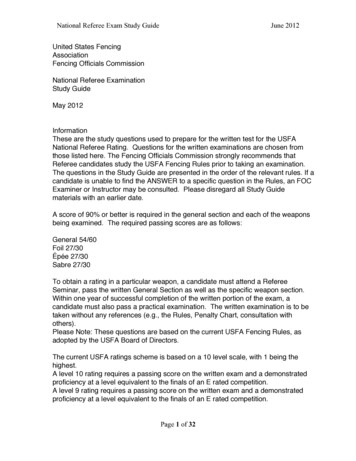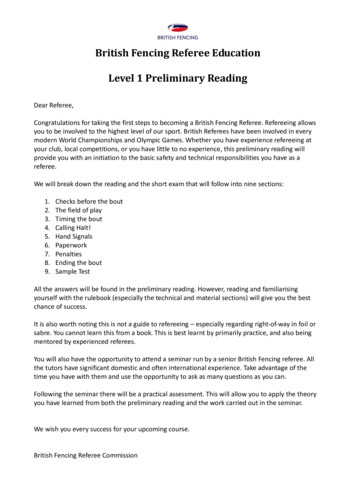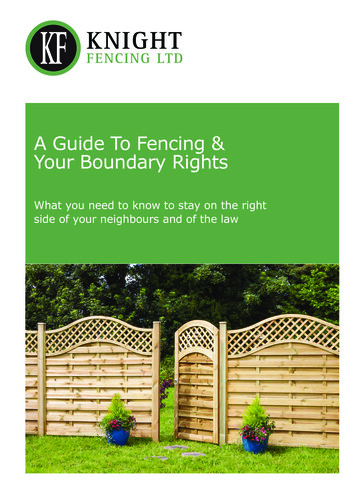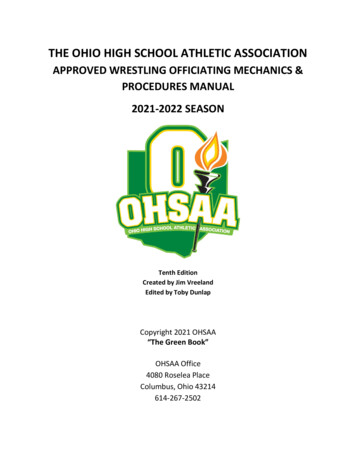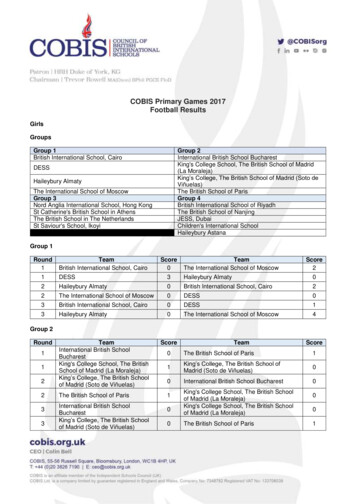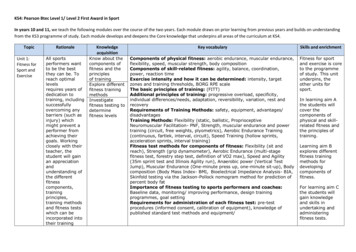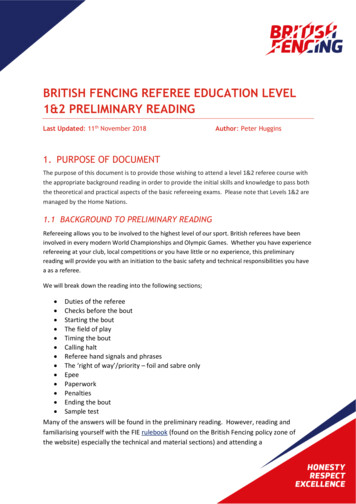
Transcription
BRITISH FENCING REFEREE EDUCATION LEVEL1&2 PRELIMINARY READINGLast Updated: 11th November 2018Author: Peter Huggins1. PURPOSE OF DOCUMENTThe purpose of this document is to provide those wishing to attend a level 1&2 referee course withthe appropriate background reading in order to provide the initial skills and knowledge to pass boththe theoretical and practical aspects of the basic refereeing exams. Please note that Levels 1&2 aremanaged by the Home Nations.1.1 BACKGROUND TO PRELIMINARY READINGRefereeing allows you to be involved to the highest level of our sport. British referees have beeninvolved in every modern World Championships and Olympic Games. Whether you have experiencerefereeing at your club, local competitions or you have little or no experience, this preliminaryreading will provide you with an initiation to the basic safety and technical responsibilities you havea as a referee.We will break down the reading into the following sections; Duties of the referee Checks before the bout Starting the bout The field of play Timing the bout Calling halt Referee hand signals and phrases The ‘right of way’/priority – foil and sabre only Epee Paperwork Penalties Ending the bout Sample testMany of the answers will be found in the preliminary reading. However, reading andfamiliarising yourself with the FIE rulebook (found on the British Fencing policy zone ofthe website) especially the technical and material sections) and attending a
BRITISH FENCING REFEREE EDUCATION LEVEL 1&2 PRELIMINARY READINGrefereeing course will give you the best chance of success. British Fencing recently launcheda FIE Rules App which can be downloaded onto your phone.It is also worth noting this is not a guide to refereeing -especially regarding ‘right-of-way’ infoil or sabre. You cannot learn from a book. This is best learnt by primarily practice,attending a refereeing course and being mentored by experienced referees.We recommend you should attend an accredited seminar run by an approved BritishFencing Referee Educator (examiner). All the tutors have significant domestic and ofteninternational experience. Take advantage of the time you have with them and use theopportunity to ask as many questions as you can.Following the seminar there will be a practical assessment. This will allow you to apply thetheory you have learned from both the preliminary reading and the work carried out in theseminar.We wish you every success for your upcoming course.2. DUTIES OF THE REFEREE (t.47) Calls the roll of competitorsDirects the boutChecks the weapons, clothing and equipmentSuperintends the proper functioning of the electrical apparatusPositions him/herself and moves in such a way to be able to be able to follow theboutPenalises faultsAwards hitsMaintains orderConsults the expert concerning electrical apparatus when necessary2.1 CHECKS BEFORE THE BOUTClothing checks; All clothing, including the glove must be in good condition without holes or tearsMinimum safety standards are determined by the type of competition – protectionlevels are usually either Level 1 (350N) or Level 2 (800N clothes, 1600N masks) 1 –you should check the requirements at the beginning of any competition.Pay close attention to the under-plastron by checking the label on the front and thatit is worn correctly.The British Fencing Safety Committee allow non-350N or 800N breeches/ trousers on young competitors. Seepage 10 of the Standards and Safety Guidelines1Version 2.01Page 2 of 10
BRITISH FENCING REFEREE EDUCATION LEVEL 1&2 PRELIMINARY READINGWearing the kit; Jackets and breeches must overlap by at least 10cm when on guard and the shoulderbraces should be worn correctlyAll female fencers must wear a chest protector2. In foil chest protectors must beunderneath the under-plastronIn foil, the lame jacket must cover the target area. In simple terms, for foil, it shouldcover at least until the top of the hips and the entire shoulder.In sabre, the lame jacket must cover any part of the body above a horizontal linedrawn between the tops of the hip bones and then continued around the fencer’strunk (see t.77.2 for foil & t.97.1 for sabre)The body wire should be clipped on the back of the sword arm aside of the lame toprevent tampering.Masks must be free of dents and soft spots; all seams must be intact, and a backstrap fitted and in good condition.Body wires and mask wires must be clipped on correctly and have no large loops ofwire hanging loose.Visor masks are no longer approved and must not be used.Blade and point checks;Epee Blade must be bent no more than 1cm in the vertical plane (either up or down)Check that the barrel is fixed and doesn’t unscrewCheck that the tip has both grub screws or is the approved screw-less types. Plastictips are currently not allowedMake sure the 1.5mm gauge fits between the tip and barrelInsert a 0.5mm gauge between the tip and barrel and then depress the tip to test thetravel (it should not register a hit)Point spring must push up a 750g weightA security device for the body wire must be inside the guard and at the spool end.You can use tape if this is missingFoil 2Blade must be bent no more than 1cm, in the vertical plane (up or down)The top 15cm of the blade from the bottom of the tip must be insulated (usuallywith tape)Point spring must push up a 500g weightIt is recommended that girls wear a chest protector from the age of ten.Version 2.01Page 3 of 10
BRITISH FENCING REFEREE EDUCATION LEVEL 1&2 PRELIMINARY READINGSabre Blade must be bent less than 4cm, in the horizontal plane (left or right)2.2 STARTING THE BOUT Call the two fencers onto the piste, check names to ensure you have the correctpeople on the pisteTest fencers’ weaponsFencers must salute spectators, the referee and each other (t.122)Satisfy yourself it is safe to proceedCall “On Guard” fencers should be behind the on-guard lines (t.22.2)“Are you Ready?” (t.22.10)“Play” (t.22.10)2.3 THE FIELD OF PLAY (t.16 to t.19)Size of the piste; A piste is 14m long and between 1.5m to 2m wide. The piste must have a run-off ateach end of 1.5m to 2mIf any part of the fencer’s foot is on a line, then the foot is on the pisteThe entire foot must completely leave the piste3It helps to consider the piste to be a volume. The boundaries extend verticallyupwards. A fencer can be on the piste even if a foot is raised.2.4 CROSSING THE BOUNDARIES (t.33 to t.36)When a fencer crosses the REAR line with both feet a hit will be scored against himWhen a fencer crosses one of the LATERAL BORDERS with one or both feet the refereemust call “Halt!” 3A hit scored by a fencer who has left the piste with only one foot is valid providedthe action was started before the “Halt!” call.A hit scored by a fencer who has left the piste with both feet is annulled if it arrivedafter the boundary was crossed.If any part of a foot remains on the piste, even if it is only by millimetres, then thatfoot is still on the piste.If one fencer leaves the piste with both feet only a hit made by the fencer whoremains on the piste with at least one foot can be counted as valid. At foil and sabreFor an infringement to have been committedVersion 2.01Page 4 of 10
BRITISH FENCING REFEREE EDUCATION LEVEL 1&2 PRELIMINARY READING the convention of priority must be followed. At epee, in the event of a double hit,the fencer with one foot on the piste will be awarded the hit and the hit of thefencer who has both feet off of the piste will be annulled.If a fencer leaves the piste and no hits have been scored, that fencer is penalised bythe loss of a metre of ground from where he left the piste. If the fencer left the pisteduring an attack he must return to the position that he occupied when he started hisaction and then will step back one metre.If the exercise of this penalty places the fencer with both feet behind the rear linethen that fencer is considered as having been hit.If no hit has been scored, then the fencers are placed “on guard” with the correctdistance between them being such that when in the “point in line” position, thepoints of the two blades cannot make contact.If a fencer crosses one of the lateral boundaries with both feet to avoid being hit, he willbe penalised with a GROUP 1 offence penalty (i.e. a YELLOW Card for a first offence and aRED Card for subsequent offenses in the same bout)If a fencer involuntarily crosses one of the boundaries (lateral or rear) as a result of anaccidental cause e.g. after having been subjected to Corps a Corps or jostling then there isNO penalty4Your tutor will demonstrate these situations.2.5 TIMING THE BOUT (t.37 TO t.44)Keeping the timing may seem easy but it is absolutely vital to get it right every single time Even if you have time-keepers, YOU are ultimately responsibleEspecially using a box without a remote control, this can require you to make veryclose calls as time expires, as many fights are won or lost in the closing seconds orbecause of time expiringIf the clock fails, you have to estimate how much time is left and tell the fencersThe basic rules A hit may not be scored after time has expired, even if the action started beforeIf the scores are tied at the end of the normal time the fencers fence for a decidinghit, with a maximum time limit of one minuteBefore the extra time starts the referee draws lots (coin toss/box random lights) todecide who has priority i.e. who will win if no hit is scored in the extra minuteIf during normal fencing, the competitors should be replaced on guard at fencing distance, a competitorcannot be placed behind the rear line. The opponent then must give ground.4Version 2.01Page 5 of 10
BRITISH FENCING REFEREE EDUCATION LEVEL 1&2 PRELIMINARY READINGA fencer may not stop the bout to ask how much time is left, but they can ask when thebout is interrupted for some other reason2.6 CALLING “HALT!”The referee calls “Halt!” at; The end of timeIf a fencer leaves the piste (as covered in the previous section)If there are any safety issues, hits or penalties that need awardingFencers pass each otherFencers cannot wield their weaponsNon-combativity (DE bouts only) t.124Other reasons for calling halt is corps-à-corps Corps-à-corps is any bodily contact between the two fencersIf a fencer is subject to corps-à-corps then the referee calls in all three weapons.Simple corps-à-corps is no longer a card-able offense in foil or sabreCorps-à-corps is still a penalty offense when carried out to avoid being hit and/orwhen jostling the opponent, see t.25.2 (t.170.1.2) and t.121.2 (t.170.1.15) –yellow/red sectionThe fencer then holds their ground, the offending fencer must give distance(however, this situation cannot force a fencer beyond their back line).Only a distance penalty for leaving the piste can result in a penalty hit2.7 REFEREE SIGNALS AND PHRASESSee associated sheet and t.632.8 THE RIGHT OF WAY (PRIORITY) FOIL AND SABRE ONLY Try to understand the theory of how one gains and regains priority The theory of what an attack is What is a parry What is a riposte What are the renewals of attack What is a counter-attack Point in line Fencing time Reading the following sections of the rule book can help but attending a refereeing coursewhere your tutor will explain and demonstrate these situations is the best solution alongwith plenty of practiseVersion 2.01Page 6 of 10
BRITISH FENCING REFEREE EDUCATION LEVEL 1&2 PRELIMINARY READING t.8 through to t.15t.82 through to t.89 for foilt.100 through to t.106 for sabre2.9 EPEE Try to understand the theory of annulling of hits through weapon and equipmentfailureHits on other than the opponent or their equipmentWhen you do not up-hold an appeal by a fencer for annulling a hitReading the following sections of the rule book can help but attending a refereeing coursewhere your tutor will explain and demonstrate these situations is the best solution alongwith plenty of practise t.8 through to t.15t.92 through to t.952.10 PAPERWORK It may seem obvious, but it is absolutely crucial that you record the outcome of about correctly on the score sheetYou must follow the bout sequence, record the final score and any penaltiesawardedEnsure you enter your name as referee on the poule/score sheetEnsure that any penalties given are written on the poule/score sheet2.11 BOUT SEQUENCE A poule sheet will have the order of the bouts shown on it in two or three columnsof figures such as 1v2, 2v4, 2v3. These are read vertically do that you complete thefirst column before starting the second. An example is on the next page.The bout scores are written in the part of a poule sheet in the grid with the fencers’names, two series of numbers, and a set of blank squares2.12 RECORDING PENALTIES (t.163) Version 2.01On each score sheet there should be a blank area below the results grid and theorder of the bouts. It is on this area that you record the details of every penalty thatyou awardFor each penalty you must record the bout in which it occurred, the name of thefencer penalized and the group of the offence (the colour of the card awarded)You do not need to record the precise offence, although you may if you wishIt is important that you do note penalties on the score sheetPage 7 of 10
BRITISH FENCING REFEREE EDUCATION LEVEL 1&2 PRELIMINARY READINGIf you don’t write it down, it never happened For example, if (in foil) you penalize a fencer for covering and award a yellow card,but fail to write this on the score sheet and later in the bout the fencer again coverand you award a red card; the fencer could appeal against the imposition of a redcard because this is his Group 1 offence. By failing to write the first penalty down onthe sheet you will have denied the fencers opponent a hitTo save time, this can be recorded in a form of shorthand (YC, RC. BC)2.13 BLACK CARD PROTOCOL If you award a black card you must make a more detailed note on the sheetWrite down the full name of the person penalised and a brief description of whathappenedWhen you get a break in the fencing you must prepare a full report of the incident,together with any ensuing aftermath, for the competition organisers to forward toBritish Fencing’s Disciplinary Committee2.14 OFFENSES AND PENALITIES (t.170)See attached sheet2.15 ENDING THE BOUTThe fencers must: Return to the en-guard lines Salute their opponent, the referee and the audience Referee must indicate the winner of the fight (see hand signals) Fencers then shake hands with each otherThe match is not complete until this is all done3. SAMPLE QUESTIONS OF THE WRITTEN TESTQuestion 1Which card would you award if the following occur? (take each in isolation)i) A fencer causes corps-a-corps to avoid being hit (Yellow / Red / Black)ii) A fencer's body wire is not working at the start of a fight (Yellow / Red / Black)iii) A fencer deliberately strikes his opponent with his guard (Yellow / Red / Black)Question 2How long is the run-off at the end of the piste required to be? (Hint: it is the same asthe required width)a) 1 metreVersion 2.01Page 8 of 10
BRITISH FENCING REFEREE EDUCATION LEVEL 1&2 PRELIMINARY READINGb) Between 1.5 and 2 metresVClub1Name234567HSHRINDPL812345678c) 2 metresQuestion 3Fencer Thompson arrives to the piste for his first match at the Bristol Open with a holein his glove. After replacing it, when doing the initial test it is found that his weapon isnot working. Furthermore, on checking his under plastron it is found to be 350N. Beforethe match begins you notice his socks are not pulled up.i) What cards do you give him?ii) What is the score when the match begins?Example of a poule sheet*HS Hits Scored**HR Hits ReceivedVersion 2.01Page 9 of 10
BRITISH FENCING REFEREE EDUCATION LEVEL 1&2 PRELIMINARY READINGVersion History (can be placed at end)VersionNumberv0.1V0.2V2.0Date UpdatedUpdated 01.2019PH/NBVersion 2.01CommentsFirst draftUpdate for re-publicationUpdated to include new t.170 rules and re-formatted toBF brandingUpdated to correct t.33-t.36Page 10 of 10
Referee hand signals and phrases The 'right of way'/priority - foil and sabre only Epee Paperwork Penalties Ending the bout Sample test Many of the answers will be found in the preliminary reading. However, reading and familiarising yourself with the FIE rulebook (found on the British Fencing policy zone of

